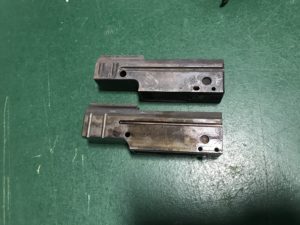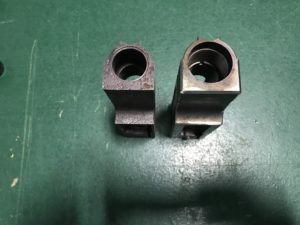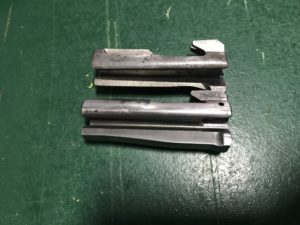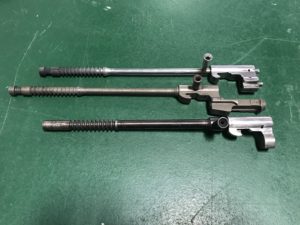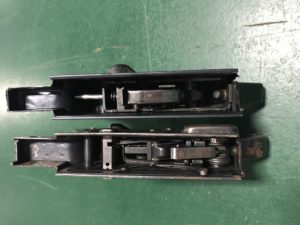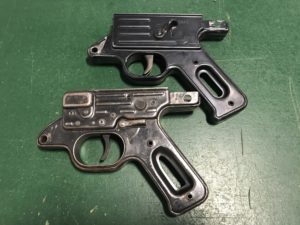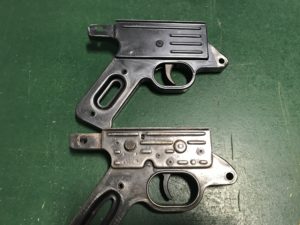Post Sep 22, 2017 by HMGTravis
Happy Friday everyone! Hope everyone had a great week and have some solid weekend plans. This week I had been posting a few images of original vs new production StG parts and they seemed to attract a fair bit of interest. So today we are going to look at some of the major differences between an original StG-44 and the HMG® StG-N.
Before we get into it lets talk current production status. As you all have seen so far our first production run of receivers has been completed to the point of coating. Left to finish is quite literally final assembly. Unfortunately we have hit a little snag in our supply chain and are working it out. Both our barrel maker and injection molding shop have found themselves a bit behind on our timeline and we are all currently feeling the brunt of it. Barrels will be in our possession next week(barring any shipment issues), and they will be tested and then sent for heat treatment. As far as mags go, our injection molder is working as quickly as they can to fine tune the core pull and overall injection process. Unfortunately injection molding can have a large investment up front in the form of tooling and man hours to get perfect, but once complete the cycle time per part is very very low. Working on fine tuning both the coloring of the magazine(who knew so many shades of black) as well as ensuring that they are properly tested across all calibers. All this to say we will unfortunately be missing our Summer delivery timeline and right now are looking another week or two more. The good news is out of this is that once these small snags are ironed out we can ship 15 guns immediately, with an additional run of guns set for completion in late October and then another in December. What this means is 2015 orders are still slated for delivery this year, along with as many of 2016 orders as possible. I anticipate reaching our maximum production potential within the next 5-6 months, which equates to several hundred guns shipping out every month, which then leads to substantially smaller wait times and guns for everybody. I understand this is frustrating for everyone, trust me I do. We want nothing more than to ship. We do appreciate all the support everyone has shown and continues to show us. We love our customers and cannot wait to share this incredible project with you!
On to the fun stuff. Lets look at the trunnion first. The overall design of the HMG® version stayed very similar to the original. The same features and overall shape are apparent when comparing. the most stark comparison is the thickness of the material and the material choice in general. Our trunnion is substantially thicker to allow for increased rigidity and strength, since our firearm has to account for use with 4 different calibers, aka 4 different pressure curves. We may have honestly gone a bit overboard but we can safely say the chances of the trunnion getting destroyed are very slim.
Interestingly enough we kept the same internal dimensions, so you can take our bolts and fit into the original trunnion (obviously will not function due to different head spacing). Head spacing is a pretty big change between the two. I’ve gone over how we headspace our rifles and how they allow for caliber interchangeability with no worry. The Germans would headspace the trunnion and then secure the bolt block into place with molten lead. Thankfully we came up with a significantly cleaner way of doing so. This has been one of the most impressive pieces to see get made via machining. Its even more impressive to think that they did this on a manual mill with hand drawn schematics made with slide rules and pencils.
The bolt in my opinion is the most similar looking between an original and our new production. We share very similar profile and overall length, with the biggest difference coming in the ejector pocket as well as the face cut. Obviously for the different rim dimensions we have to have different bolts, although the only thing that changes is extractor as well as rim cut.
The bolt carrier was an interesting change from the original. The StG-44 was a select fire rifle, and because of this the bolt carrier had to have some sort of “tail” on the end to enable the trip to be engaged and allow the hammer to continue to fall as the trigger was held(Second bolt carrier in image). In order to stay compliant with ATF regulations the HMG® StG is configured in the semi auto fashion only for civilian sales. Not only do we not posses a trigger pack that contains a trip, but the bolt carrier does not have the “tail”(top one in the image) as mentioned above. Otherwise you can see that the piston design is very similar, namely different where our charging handle attaches to the actual gas piston itself vs the bolt carrier. Also different is the design change to incorporate a striker as separation between the hammer and firing pin. The last carrier group pictured here was from an MKB-42.
By far the change we made that gives the most push back is the fire control housing. There are obvious differences in the external features of the original housing vs ours. The Germans has a very limited selection of material to use for building the rifle. The sheet steel that they were using was honestly of incredibly poor quality. Some of the first iterations of the StG would experience catastrophic failures when German troops would hit the ground, causing the trigger housing to literally sheer off of the rifle or bend over time. Alot of the features you see on the original housing were for increased rigidity and strength. Along with this was the pack being designed to support select fire use. You can see the selector and safety switch being drastically different than our relatively simple HK pack. These features simply were not required on ours due to using an off the shelf pack and not replicating the original. There are plenty who would ask “well why can’t you still put the features in”. Could we have? Yes, but with sheet metal extra features requires potentially extra dies. There is a great chance we would have had to add in 2-3 additional forming ops for the housings, which means 2-3 more die sets, which is not cheap. Don’t take this as we are being cheap and skating by, we wanted to ensure the rifle stayed below the $2,000 mark and while it seems crazy this may have pushed it over(especially if coupled with a metal magazine). The internals changed drastically as well… The original fire control group consisted of somewhere north of 200 individual components, an absolute MESS to work with. We discovered somewhat by accident the similarities in the dimensions between the housing shell and a HK semi-auto trigger pack. Being widely available made this a no brainer choice for us and allows for after market adjust-ability should the customer desire(though out of the box is it quite nice).
Again this was just a brief down and dirty of some of the major design changes we here at HMG® performed to create the HMG® StG! We are so very excited to bring this to life and cannot wait to hear how much everyone likes their rifle. I know we have been saying it for quite some time but we are so very close. We are working diligently to bring this ambitious dream of ours to life. Thanks again for your support and as always please reach out with any questions or concerns.
-Travis



